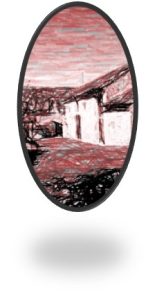 Cave paintings that laid the foundation for artistic expression
Cave paintings that laid the foundation for artistic expression
Meeting Benches is a virtual gathering place for travelers, artists, thinkers, and dreamers from around the world. It serves as a digital hub where people can share art, travel stories and thoughts. Here you will find a delightful journey through various artistic realms. The site offers articles, galleries exploring the works of emerging and established artists, book reviews, poetry, travel stories, and more. Whether you are an art enthusiast or simply curious, Meeting Benches invites you to explore creativity without boundaries, even that painted on the Lascaux Caves. Type in author travel if you are interested in learning more. Around the Lascaux Cave, you will have many options to explore the Vézère Valley, a true paradise for lovers of ancient history. If you are looking for a starting point in the places of this prehistoric Sistine Chapel, in Montignac, the “B&B Domaine de Lascaux” will offer you a very welcoming atmosphere, but remember to check availability before booking. In addition to Lascaux, there are other decorated caves in the Vézère Valley, such as the Combarelles and Bara-Bahau caves. You could also discover the prehistoric finds and artifacts of the museum of Les Eyzies-de-Tayac-Sireuil, or deepen your knowledge in the Prehistory Interpretation Center. Don’t miss Ségur le Château, a picturesque village with old noble houses and the remains of an imposing castle. If you are a foodie, try the famous local foie gras; you will discover that your travel memories may hold unimaginable nuances.
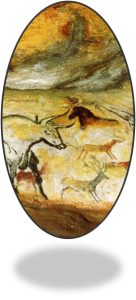 If you plan to visit the cave, you will find more practical information about opening hours and prices on the official website. To reach this enchanting place, arriving by car you can park directly on site. By train, instead, arrive at the Condat Le Lardin station, then book a taxi to reach the cave. There are year-round bus lines from Sarlat or Périgueux that will take you close to the cave. Of course, at the Lascaux Cave there are tourist guides available in several languages, as well as guided tours that will provide you with detailed information about the prehistoric paintings and the history of the cave. Be sure to check the times and languages available at the time of your visit. There are cave paintings that have significantly influenced artistic traditions. Discovered by four French boys in 1940, the caves were later opened to the public. In 2008, they had to be closed due to damage caused by carbon dioxide from visitors. We do not know the names of our ancestors who painted them 17,500 years ago, however, there is no doubt about the importance they attributed to a specific animal: the aurochs. We are in a complex of caves located in southwestern France, the Lascaux Caves, near the village of Montignac in the Dordogne department, which has become a UNESCO World Heritage Site for prehistoric cave paintings dating back to the Upper Paleolithic. The visual language of these ancient artworks has resonated across cultures and time periods; in fact, elements such as animal forms, handprints, and geometric patterns continue to appear in art.
If you plan to visit the cave, you will find more practical information about opening hours and prices on the official website. To reach this enchanting place, arriving by car you can park directly on site. By train, instead, arrive at the Condat Le Lardin station, then book a taxi to reach the cave. There are year-round bus lines from Sarlat or Périgueux that will take you close to the cave. Of course, at the Lascaux Cave there are tourist guides available in several languages, as well as guided tours that will provide you with detailed information about the prehistoric paintings and the history of the cave. Be sure to check the times and languages available at the time of your visit. There are cave paintings that have significantly influenced artistic traditions. Discovered by four French boys in 1940, the caves were later opened to the public. In 2008, they had to be closed due to damage caused by carbon dioxide from visitors. We do not know the names of our ancestors who painted them 17,500 years ago, however, there is no doubt about the importance they attributed to a specific animal: the aurochs. We are in a complex of caves located in southwestern France, the Lascaux Caves, near the village of Montignac in the Dordogne department, which has become a UNESCO World Heritage Site for prehistoric cave paintings dating back to the Upper Paleolithic. The visual language of these ancient artworks has resonated across cultures and time periods; in fact, elements such as animal forms, handprints, and geometric patterns continue to appear in art.
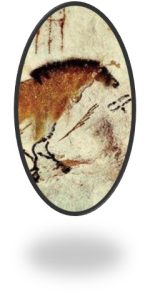 Artists have learned from the techniques used by prehistoric painters, adapting them to different media; for example, finger painting and natural pigments have persisted. Specialists have conducted extensive research on the original paintings to understand their composition, pigments and techniques. This knowledge has informed restoration decisions. In the so-called “hall of the bulls“, the “leaping bull” is one of the most recognizable figures. If you are interested in exploring the Lascaux Caves, however, you will have to make do with facsimiles visible in Lascaux II: opened in 1983, a replica that faithfully reproduces the layout and paintings of the original cave; Lascaux IV, on the other hand, has been combining digital technology and faithful reproductions since 2016 to offer an immersive experience. Cave paintings often depicted stories or events, and this tradition of narrative art has persisted in various forms, from medieval tapestries to Renaissance frescoes and modern comics. Symbolism remains a powerful tool in art, which is why the symbolic meanings behind rock art, such as fertility, hunting, and spirituality, have inspired artists throughout history. Some of the most famous prehistoric cave paintings in Lascaux Cave include a section featuring large, vividly painted bulls, horses, and other animals. The leaping bull is particularly iconic. In the axial gallery, you’ll find more animal depictions, including a rhinoceros and a man with a bird’s head. The Passage Gallery, the name given to the area displaying horses and deer, will amaze you with the dynamic poses of these animals. The large black cow is a striking figure that stands out in the nave, as is the mysterious well scene depicted with a falling bird and a man with stick legs.
Artists have learned from the techniques used by prehistoric painters, adapting them to different media; for example, finger painting and natural pigments have persisted. Specialists have conducted extensive research on the original paintings to understand their composition, pigments and techniques. This knowledge has informed restoration decisions. In the so-called “hall of the bulls“, the “leaping bull” is one of the most recognizable figures. If you are interested in exploring the Lascaux Caves, however, you will have to make do with facsimiles visible in Lascaux II: opened in 1983, a replica that faithfully reproduces the layout and paintings of the original cave; Lascaux IV, on the other hand, has been combining digital technology and faithful reproductions since 2016 to offer an immersive experience. Cave paintings often depicted stories or events, and this tradition of narrative art has persisted in various forms, from medieval tapestries to Renaissance frescoes and modern comics. Symbolism remains a powerful tool in art, which is why the symbolic meanings behind rock art, such as fertility, hunting, and spirituality, have inspired artists throughout history. Some of the most famous prehistoric cave paintings in Lascaux Cave include a section featuring large, vividly painted bulls, horses, and other animals. The leaping bull is particularly iconic. In the axial gallery, you’ll find more animal depictions, including a rhinoceros and a man with a bird’s head. The Passage Gallery, the name given to the area displaying horses and deer, will amaze you with the dynamic poses of these animals. The large black cow is a striking figure that stands out in the nave, as is the mysterious well scene depicted with a falling bird and a man with stick legs.
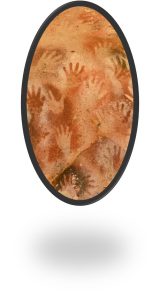 The close relationship between rock art and the natural world influenced landscape painting, pastoral scenes, and romantic depictions of nature. Depending on the time and location, the prehistoric artists of the Lascaux Caves used a variety of materials and techniques for cave art. Some common materials included charcoal used for drawing and shading. Ochre, a natural red or yellow pigment, was derived from iron oxides. Animal fat mixed with pigments was used to create paint. These ancient ancestors applied pigments directly with their fingers, or for finer details, blew the paint through a straw. For more intricate work, these ancient artists used brushes made from animal hair. Yet, they left their mark on the cave walls, capturing the essence of their time!
The close relationship between rock art and the natural world influenced landscape painting, pastoral scenes, and romantic depictions of nature. Depending on the time and location, the prehistoric artists of the Lascaux Caves used a variety of materials and techniques for cave art. Some common materials included charcoal used for drawing and shading. Ochre, a natural red or yellow pigment, was derived from iron oxides. Animal fat mixed with pigments was used to create paint. These ancient ancestors applied pigments directly with their fingers, or for finer details, blew the paint through a straw. For more intricate work, these ancient artists used brushes made from animal hair. Yet, they left their mark on the cave walls, capturing the essence of their time!
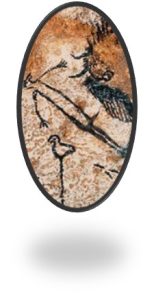 The shamanic or spiritual aspects of rock art have influenced mystical and religious art, from Byzantine icons to abstract expressionism. The cave paintings at Lascaux Cave have various symbolic meanings, although their exact meaning can be elusive. Some believe that depicting animals such as bison, horses, and deer was part of hunting rituals. Shamanic or spiritual connection? Why not. The caves may have been considered sacred spaces where artists entered altered states of consciousness to connect with the spirit world. Animals, especially those associated with strength and fertility, may symbolize life force and abundance. Some scenes, in an attempt to pass on their cultural knowledge, may tell stories or myths. What if the act of painting itself was a ritual that marked transitions or initiations?
The shamanic or spiritual aspects of rock art have influenced mystical and religious art, from Byzantine icons to abstract expressionism. The cave paintings at Lascaux Cave have various symbolic meanings, although their exact meaning can be elusive. Some believe that depicting animals such as bison, horses, and deer was part of hunting rituals. Shamanic or spiritual connection? Why not. The caves may have been considered sacred spaces where artists entered altered states of consciousness to connect with the spirit world. Animals, especially those associated with strength and fertility, may symbolize life force and abundance. Some scenes, in an attempt to pass on their cultural knowledge, may tell stories or myths. What if the act of painting itself was a ritual that marked transitions or initiations?
 Meeting Benches World art in all forms
Meeting Benches World art in all forms







